What to do in Crete
You’ll find balmy temperatures, milky-blue skies and generous local hospitality on a guided spring walk in Greece.
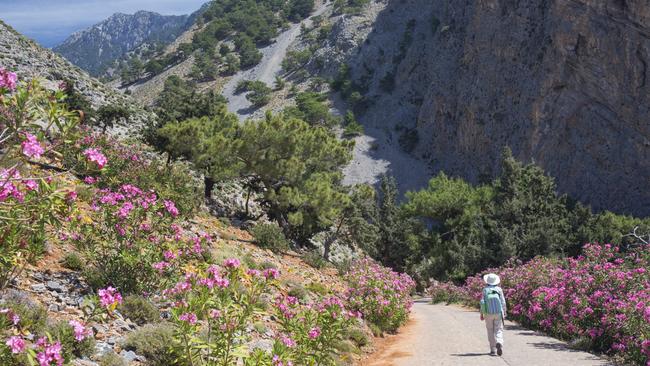
If you’ve ever visited Greece, you may have come across Xenia, an endearing custom in which Greeks show hospitality towards complete strangers. Never mind if you don’t speak a word of the language; in rural areas this timeworn ritual still rules. And it’s something we’re enjoying right now in western Crete as we hike to the tucked-away hamlet of Maza.
Seated on a balcony beneath a drowsy blue sky is an old gent. He’s wearing a grubby white vest, and across his lap is a stringed instrument we later learn is a lyra. One glance at our assembled party and Sifis (for that is his name) starts gesticulating. “Stop! Rest your feet, relax!” he shouts. “Have some raki, and I will play you some music.”
We feel complete frauds as we’ve only walked a few steps from our minibus, but this is a command that brooks no argument. While Sifis plays, two of his 14 grandchildren scurry off to the kitchen, quickly returning with a flask of fiery homemade raki alongside carob biscuits and sticky halwa.
It’s just one of many lovely local moments we experience during a week-long guided spring walk through western Crete. And goodness, spring is a prime time to visit. The temperatures are balmy, swifts kamikaze through milky-blue skies, and luminous landscapes reveal trees in bud, and bountiful indigenous wildflowers underfoot.
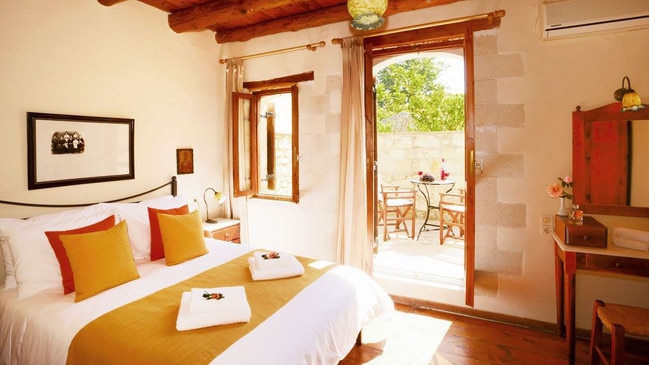
Beneath vine-covered trellises at rural kafenion, old men nurse tiny cups of bitter cardamom coffee. Raggedy cats snooze in the shade, and in the surrounding fields, ancient farming techniques are still used to cultivate bitter horta greens, artichokes and citrus fruits.
These are some of the additional delights I absorb on walks through the dramatic Samarian and Silikali gorges and around the hidden corners of Crete’s west. But even better are the insights we glean from our guide, British expat and Cretan expert, Jonathan Peat. With his insider knowledge, we get to visit remote villages you could easily miss on a solo holiday and – as with our new-found friend Sifis – there are those entertaining encounters with locals.
“Home” for our week is Arosmari Village Hotel on the fringes of Vamos, an unspoilt 18th-century village set against the backdrop of the snow-draped White Mountains. Arosmari’s sensitively converted stone and cypress-wood cottages are idyllic, comprising kitchenettes, open-plan living rooms, wood-beamed bedrooms and shady terraces.
These vary both in size and style, but all retain a characterful authenticity. Some have huge terraces overlooking the mountains; others, like our cottage, Fennel, are more intimate, with fireplaces and smaller patios. Yet it’s Arosmari’s wonderful garden that takes centre stage. Roses and lavender bushes encircle a miniature chapel and ancient stone shepherd’s hut. There’s an enormous swimming pool and many dreamy corners where calico-cushioned lounges are shaded by lemon and orange trees.
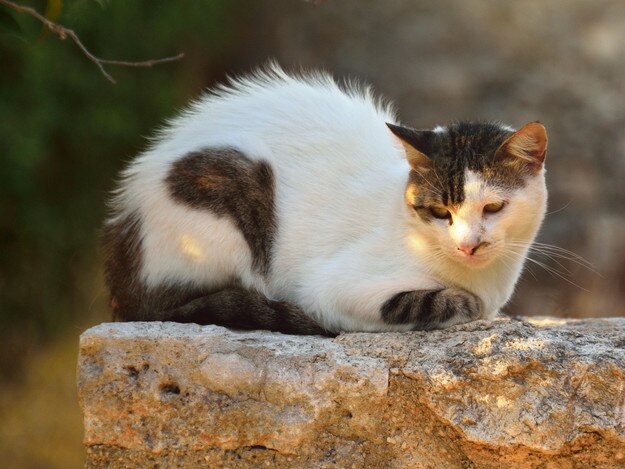
With your feet mildly throbbing from the day’s walk, you can easily while away an afternoon here. And lulled by the chatter of birdsong, perhaps with a glass of chilled local wine from the honesty bar to hand, the inevitable postprandial snooze soon follows.
Mornings, however, are all about activity. Following a splendid buffet breakfast where we stock up on creamy goats’ yoghurt, Cretan bread slathered with fragrant village honey, alongside warm cheese and spinach pies, we stagger to the minibus to meet Jonathan. Each morning he kicks off with a “Thought for the Day”. One time, it’s a passage about Crete by Lawrence Durrell in which the author describes the landscapes as having a quality that “wallpapers your dreams”; another day, it’s a poem by Persian poet Rumi; or a first-hand account of the islanders’ harrowing sufferance during World War II.
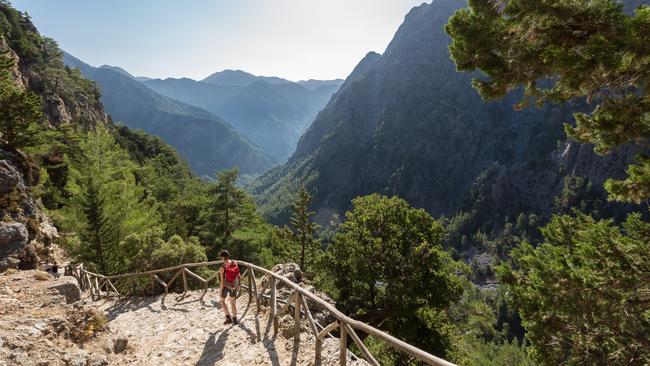
These readings are much appreciated by our group of 15 (all middle-aged plus), and help to enhance the meditative quality of our walks. Though stamina levels vary, bonds are quickly formed. All the walks are moderate and optional, and in truth, it’s more a holiday with walks and eats, than a walking holiday. Even so, there’s one day when we’re left bludgeoned by tiredness. Instinctively, we work as a team. When someone struggles, others step in to assist.
Thankfully, Jonathan breaks us in slowly. Our first day sees us heading to the flower-covered plateau of Megala Xorafia, near the Minoan city of Aptera. Warmth crests the air; the light is hazy and ravishing, and at times it feels as if we are wading through a giant salad bowl. This quickly becomes my favourite hike of the week, not just for its panoramas on to the Mediterranean, and fascinating archaeological ruins, but equally for the lush flora underfoot.
Tiny orchids shelter beneath thick Jerusalem sage; sea squill neighbour dazzling Quink-blue pimpernels. And while we swish through verdant meadows and along ancient Venetian pathways, Jonathan shares his recipes for plant potions, alongside anecdotes about local characters.
Later, the pleasure ramps up a notch as we return to base through citrus groves replete with sweet oranges, tangerines and grapefruits. Occasionally we stop to pluck and then eat a perfectly ripened fruit from an overhanging branch.
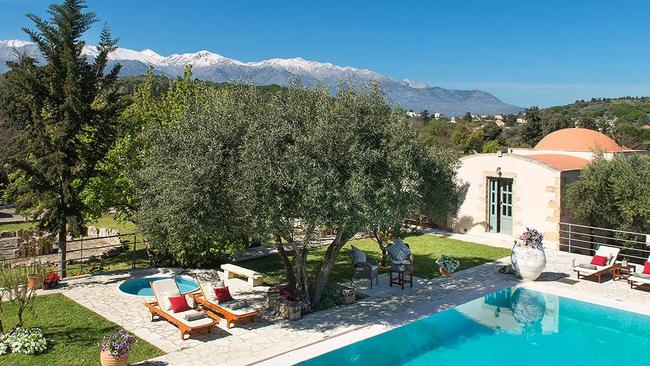
Every day there’s a fabulous lunch at the sort of tavernas you’d never find without the help of someone with local know-how. In fact, the whole trip becomes a gourmet delight: take Taverna Moustakas, in Silos, where we guzzle never-ending meze, then salty, oil-slicked lamb chops and a punchy local wine. Any guilt we have about tucking into such huge meals is offset by the knowledge that everything we eat is organic and homegrown.
Cretans, a recent study discovered, lead the world in longevity. In rural communities, diabetes and dementia are pretty much unheard of, and a high proportion of the population lives well into their nineties. Put that down to the seasonal omega 3-rich diet, then add on strong family bonds and a positive attitude to life. And positivity we certainly find during our encounters with villagers.
One afternoon, after an arduous hike through the Silikali Gorge where waterfalls freshen the air and goats cling precariously to arid mountain ridges, we finally stop at Kasteli. Spirits lift as motherly Soula appears, her arms laden with baking trays of warm stuffed tomatoes and capsicums, and an impromptu picnic is set up in the shade of a church.

Soon, along comes beekeeper Yannis, whose 300 hives freckle the gorge’s thyme-covered slopes, and when one of our group of walkers confesses to owning bees, Yannis proudly grins: “But how many tons of honey do you produce?” he demands. “Me? I make three tons.”
Our walk at Akirotiri is pleasingly atmospheric. Scrambling down a vast ravine dotted with abandoned monastery churches and hermit caves, we encounter an empty landscape where griffon vultures comb the wind-bristled skies, and the air comes fragranced with wild herbs. Our reward? Another picnic, courtesy of Jonathan’s French wife, Myriam. Reclining on rugs like a troupe of ancient Greek gods, we feast on beetroot and feta salads and warm baked aubergines,
“The government a while back asked the monasteries to be the forerunners in the organic movement here.” Jonathan tells us, gesturing. “Hence those vineyards, the olive oil, the honeys.” I ponder on this, and realise that despite clinging to age-old traditions, Crete is exceptionally forward-thinking. Already, I can sense my retirement plans shifting to include multiple visits here. Well, a girl can dream, can’t she?
In the know
Simpson Travel offers seven-night guided walking holidays in western Crete in spring and autumn. From $1992 a person twin-share (no single supplement in April 2023); includes accommodation, all transfers, breakfasts, lunches, picnics and welcome dinner. Arosmari Village Hotel is about 30 minutes’ drive from Chania International Airport in the island’s northwest.
Louise Roddon was a guest of Simpson Travel.

To join the conversation, please log in. Don't have an account? Register
Join the conversation, you are commenting as Logout